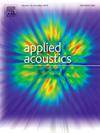Load frequency modulation control system of piezoelectric ultrasonic transducer based on LADRC
IF 3.4
2区 物理与天体物理
Q1 ACOUSTICS
引用次数: 0
Abstract
Ultrasonic processing technology is widely employed in various industrial applications, including welding, metal forming, and machining. In the practical operation of piezoelectric ultrasonic transducers, the piezoelectric ultrasonic transducers experience a resistance force from the workpiece, leading to a shift in resonance frequency. This shift significantly reduces the performance and service life of the piezoelectric ultrasonic transducers. To address this issue, this paper proposes a resonance frequency tracking algorithm for piezoelectric ultrasonic transducers, based on a Linear Active Disturbance Rejection Control (LADRC) system. The algorithm tracks the resonance frequency by controlling the impedance phase difference of the piezoelectric ultrasonic transducers, effectively reducing impedance phase difference to zero. This enables real-time tracking of frequency changes, enhances system robustness and anti-jamming capability, and improves the stability and reliability of the control system. Simulation and experimental results demonstrate that the LADRC method can rapidly and stably perform secondary frequency tracking with minor overshooting, even under conditions of no-load resonance, sudden force loads, and electric load fluctuations. These results highlight the method’s robustness and adaptability. The proposed approach ensures stable resonance frequency tracking of piezoelectric ultrasonic transducers under load conditions, offering significant practical value in real-world applications.
基于LADRC的压电超声换能器负载调频控制系统
超声波加工技术广泛应用于各种工业应用,包括焊接、金属成形和机械加工。在压电式超声换能器的实际工作中,压电式超声换能器受到来自工件的阻力,导致共振频率发生移位。这种转变大大降低了压电超声换能器的性能和使用寿命。为了解决这一问题,本文提出了一种基于线性自抗扰控制(LADRC)系统的压电超声换能器谐振频率跟踪算法。该算法通过控制压电超声换能器的阻抗相位差来跟踪谐振频率,有效地将阻抗相位差降至零。这样可以实时跟踪频率变化,增强系统的鲁棒性和抗干扰能力,提高控制系统的稳定性和可靠性。仿真和实验结果表明,即使在空载谐振、突然力载荷和电负载波动等情况下,LADRC方法也能快速稳定地进行二次频率跟踪,且超调较小。这些结果突出了该方法的鲁棒性和适应性。该方法保证了压电超声换能器在负载条件下的稳定谐振频率跟踪,在实际应用中具有重要的实用价值。
本文章由计算机程序翻译,如有差异,请以英文原文为准。
求助全文
约1分钟内获得全文
求助全文
来源期刊

Applied Acoustics
物理-声学
CiteScore
7.40
自引率
11.80%
发文量
618
审稿时长
7.5 months
期刊介绍:
Since its launch in 1968, Applied Acoustics has been publishing high quality research papers providing state-of-the-art coverage of research findings for engineers and scientists involved in applications of acoustics in the widest sense.
Applied Acoustics looks not only at recent developments in the understanding of acoustics but also at ways of exploiting that understanding. The Journal aims to encourage the exchange of practical experience through publication and in so doing creates a fund of technological information that can be used for solving related problems. The presentation of information in graphical or tabular form is especially encouraged. If a report of a mathematical development is a necessary part of a paper it is important to ensure that it is there only as an integral part of a practical solution to a problem and is supported by data. Applied Acoustics encourages the exchange of practical experience in the following ways: • Complete Papers • Short Technical Notes • Review Articles; and thereby provides a wealth of technological information that can be used to solve related problems.
Manuscripts that address all fields of applications of acoustics ranging from medicine and NDT to the environment and buildings are welcome.
 求助内容:
求助内容: 应助结果提醒方式:
应助结果提醒方式:


